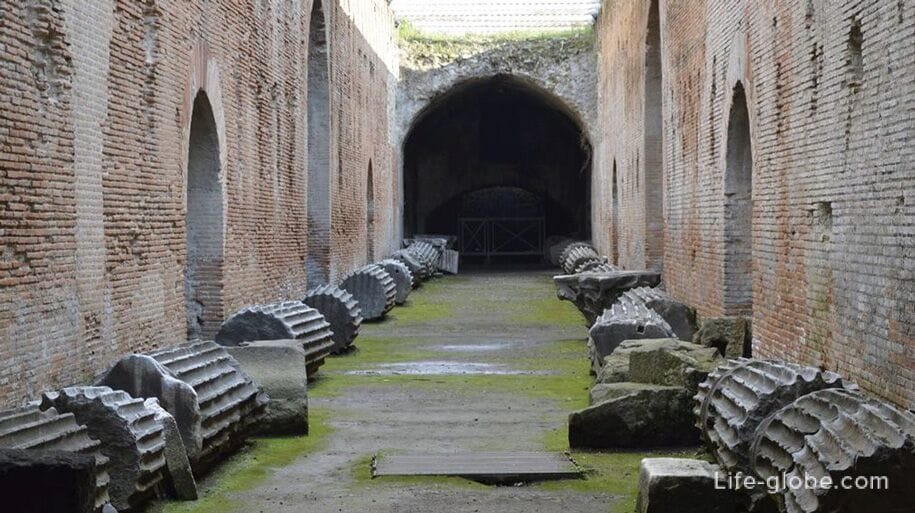
«Underground Naples», a so - called part of Naples, hidden under the ground and which is a separate, not quite ordinary group of sites that make up the unique route.
Since Naples was founded by Greek settlers in the 8th century BC and during its history belonged to several Nations, which in turn also left a mark, at the present time, Naples is one of the best examples of cities in which history can be traced through the "underground strata".
Today between the Greek Naples and the modern city is not Millennium, and meters of the subsoil, cut by a dense network of tunnels and cavities, forming a city beneath the city, consisting of an underground burial complexes with early Christian basilicas, the roads between the buildings and remains of ancient buildings, aqueduct and water reservoir, the Roman Agora, as well as bridges and walls built by the Bourbons.
The underground city extends beneath the historical center and goes North, it is associated with myths and legends. For centuries galleries near Naples were used in different ways. Born after the extraction of the tuff to build the city, they were used as aqueducts, and as shelters during the Second world war.
Currently, a considerable part of the underground object is still hidden and unexplored.
The catacombs of Naples is one of the most striking examples of "Underground Naples".
Catacombs are underground paleo-Christian burial consisting of excavated in the tuff tunnels clinics or peripheral corridors, along which there were burials, and underground spaces, and Basil, preserved the remains of mosaics and frescoes.
The catacombs are located in the Northern part of Naples, in the sanità neighborhood (Stella / Rione Sanità), which was once a necropolis and cemetery.
Under the sanità neighborhood are at least nine of the catacombs and funerary complexes, of which only a few were detected, namely: San Gennaro, San Gaudioso and San Severo.
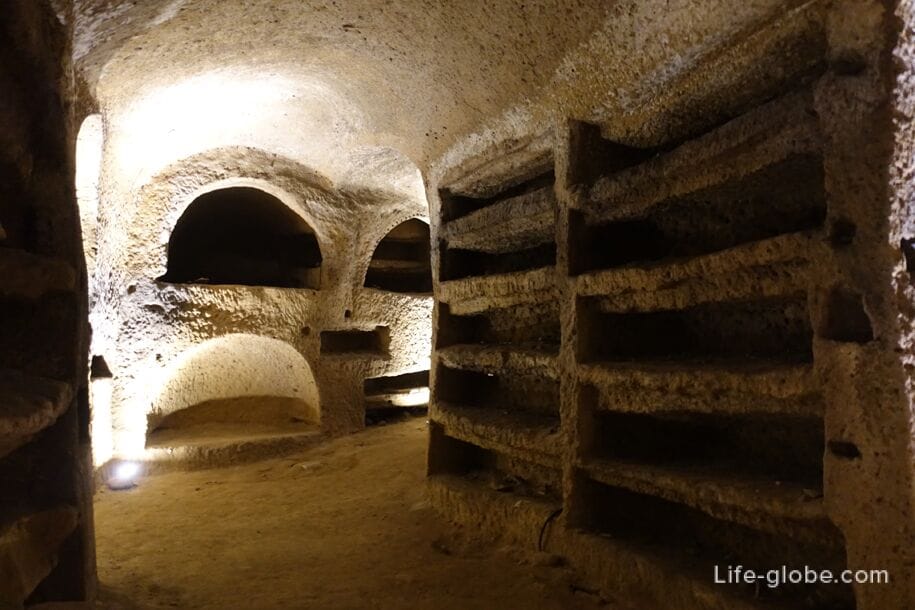
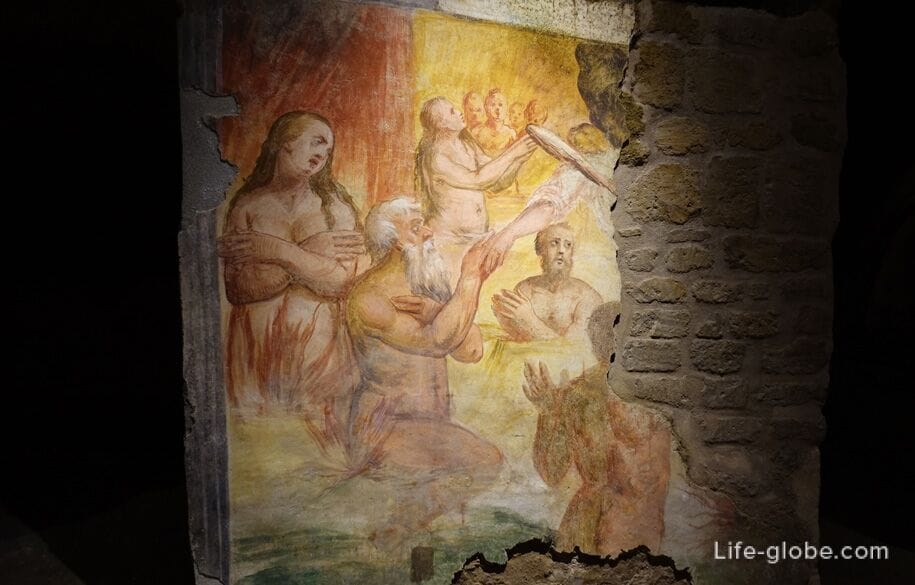
The largest Christian catacomb complex in southern Italy and one of the oldest cemeteries of the early period of Christianity, the core of which dates back to the 2nd century ad.
The catacombs of San Gennaro are located on two disjoint levels, characterized by wide spaces and two underground basilicas.
At the bottom of the catacombs the remains of Sant Agrippina - the first patron Saint of Naples, over the tomb which was carved underground Basilica. Also in the bottom catacombs are: the impressive lobby with high ceilings up to 6 meters, containing a bath for the baptism and a dense network of tunnels on both sides which houses the burial.
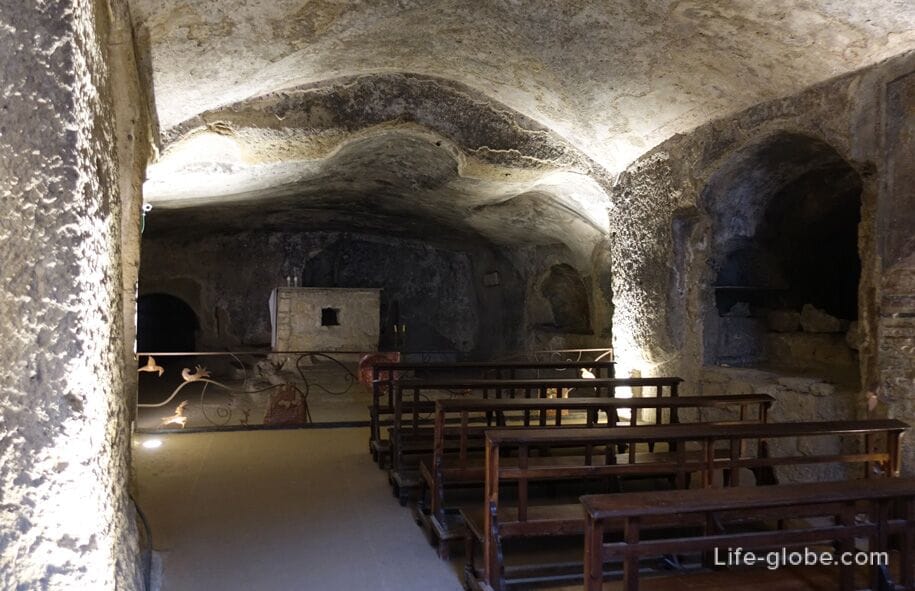
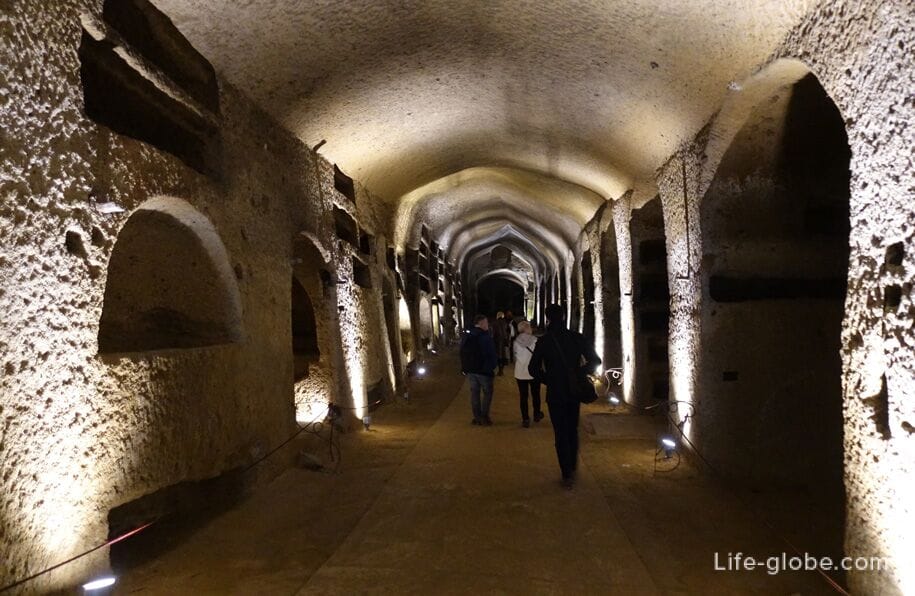
The upper part of the catacombs - the place where they were transferred the remains of San Gennaro (St. Januarius) is the Martyr, the patron Saint of Naples. In the upper part are also spacious corridors, the Crypt of the bishops where they were buried bishops of the city, and which extended to a higher level, around the tomb of San Gennaro and the Basilica with three naves, built to commemorate the transportation of the remains of San Gennaro in the catacombs. Read more about the catacombs of San Gennaro...
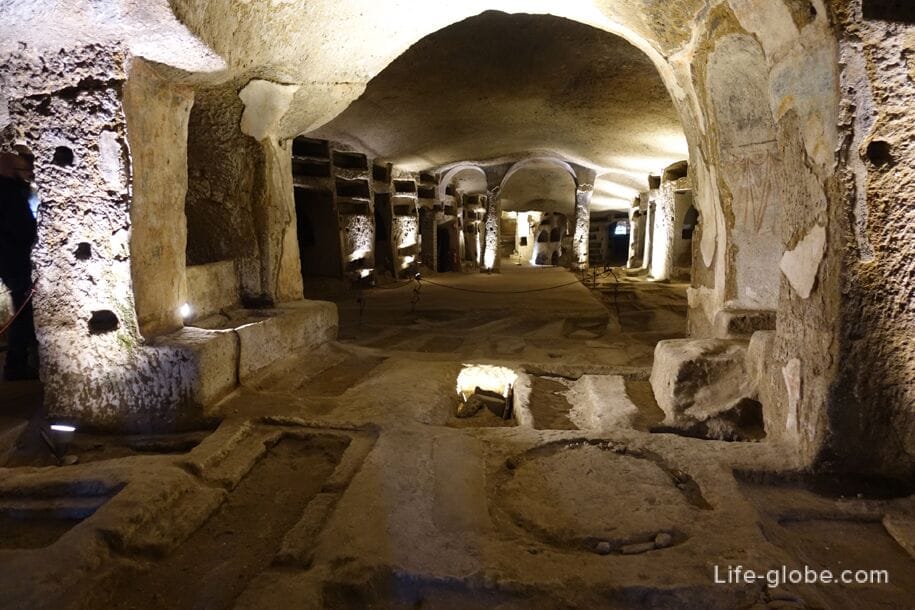

Above the catacombs, between 1602 and 1610 was built the Basilica of Santa Maria della Sanita (Basilica di Santa Maria della Sanità), which is currently being access to the catacombs of San Gaudioso.
In the catacombs were buried St. Gaudioso - Bishop of North Africa, exile, stayed in Naples and lived in town until his death. The burial took place between 451 and 453 years, after which the place became the object of veneration and known under his name.
Since then the catacombs have been expanded, and from 17 in the catacombs were placed mainly graves of aristocrats and priests.
The tombs of the nobles and of the clergy was constructed in accordance with a procedure: the skull was attached and seen in the outpatient walls, while other parts of the bodies were painted, usually with a picture of the clothes and items that could talk about the social status of the dead. Read more about the catacombs of San Gaudioso...
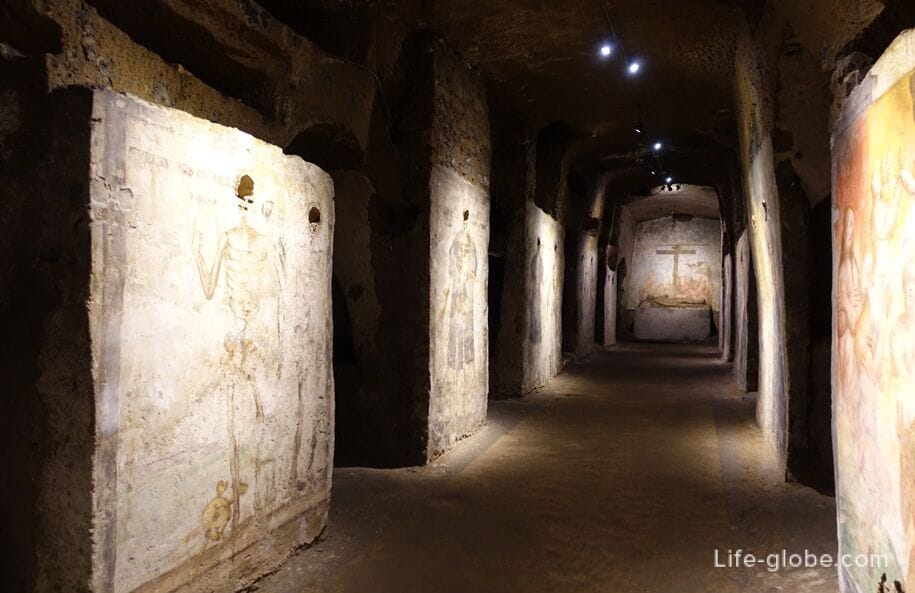
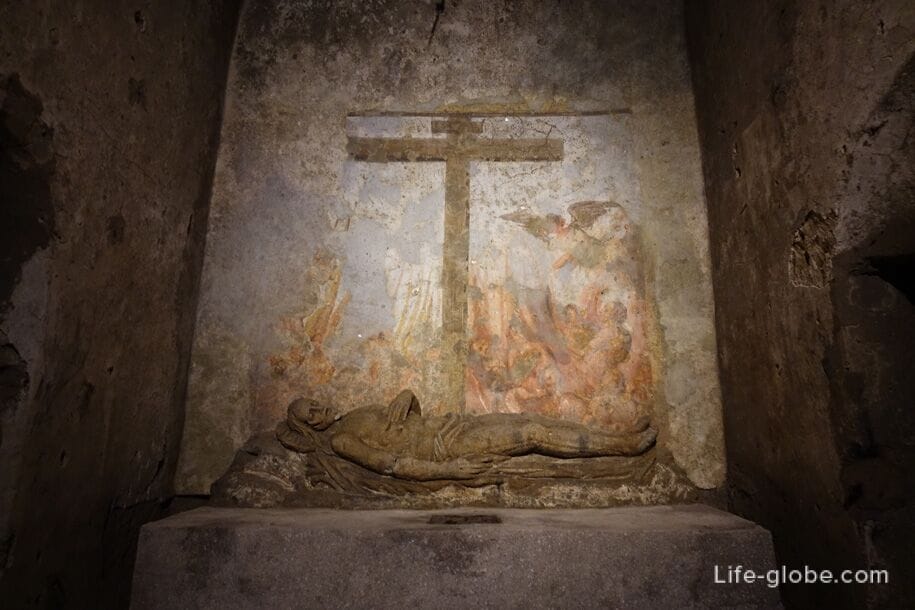

San Severo was the eleventh Bishop of Naples, between 363 and 409 BC. His bishopric was at that time when Christian faith was threatened by paganism and Arianism. Despite this, he managed to achieve the prosperity of Christianity, becoming the spiritual leader of the Neapolitan Christians.
During intense pastoral activity, the Bishop of the North had built four basilicas. Among them the Basilica outside the city walls, which he decided to be buried. The catacombs of San Severo is faced with the same fate as the catacombs of San Gennaro and San Gaudioso - in the ninth century, they left the faithful and pilgrims after the transfer of the relics of the North in the city walls.
The catacombs under the Basilica of San Severo (Basilica di San Severo) built in the sixteenth century on the site of the cemetery, was rebuilt in 1680 by the architect Dionisio Lazzari. In the spring of 2017, the Basilica was restored.
Catacomb of San Severo dates from the fifth century ad. Were opened Gennaro Galante Asprano in 1867. From the original catacombs to date remained almost square room carved into the tuff, frescoes and arkosoly (excavation for burial), which are still visible, some of them partially intact, while others are almost not decipherable.
Catacomb of San Severo is not yet available to the public.
The ancient cemetery of Naples, is currently not used for its intended purpose and which is a crypt where you can see the skeletal remains of people.
The cemetery is located in the cave in the tuff rock, consists of three large tunnels trapezoidal cross-section connected by side corridors (passages), each of which has its own name.
The left corridor is called the passage of the priests because in it are the remains coming from the territories of the churches and parishes; the Central nave is called the passage of the plague, because it contains the bones of those who died because of the terrible epidemics; right of passage called the nave percentile - it was collected the bones of the poor.
The sides of each aisle are fenced, which contains the skull, the large tibia and the femur. Many bones and skulls just piled in heaps, while others are in boxes. Read more about cemetery of Fontanelle...
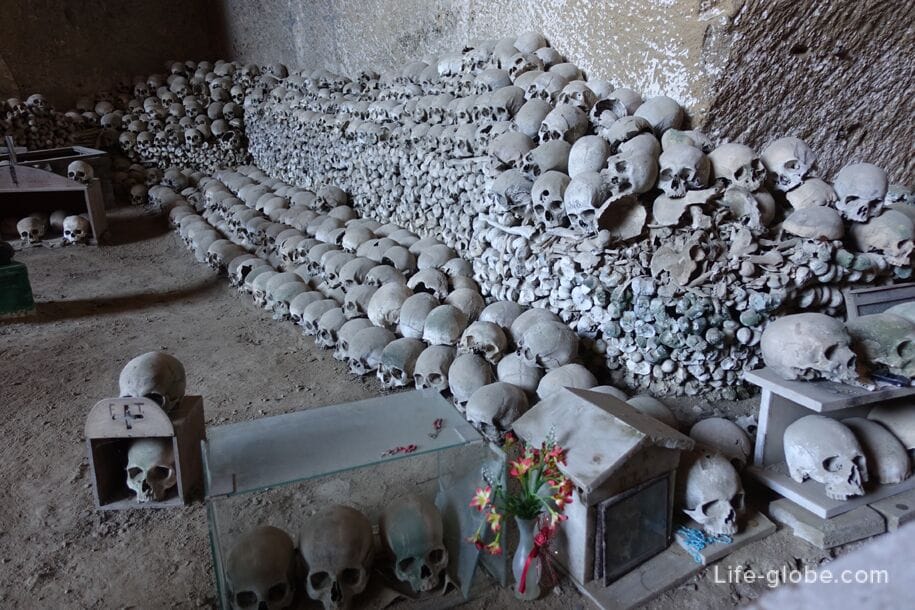

The archaeological complex "Buried Neapolis" - the dungeon under the Church of San Lorenzo Maggiore (Complesso monumentale di San Lorenzo Maggiore) located in the place where once stood the Agora - the living space of the Greek city, which later became the Roman forum.
Currently, the Museum is an underground archaeological area, where you can stroll along the ancient Roman road width of 3 meters, along which are the remains of shops such as a bakery, winery and Laundry, once oulebsir this place. There are also preserved mosaic floors and parts of ancient buildings.
The entrance to the Museum is paid, the price of the ticket is 9 Euros; students and people over 65 years - 7 €; children up to 18 years 6 €. Opening hours: daily from 09:30 to 17:30 hours.
Attention! Opening hours and ticket prices may change, please check before visiting.
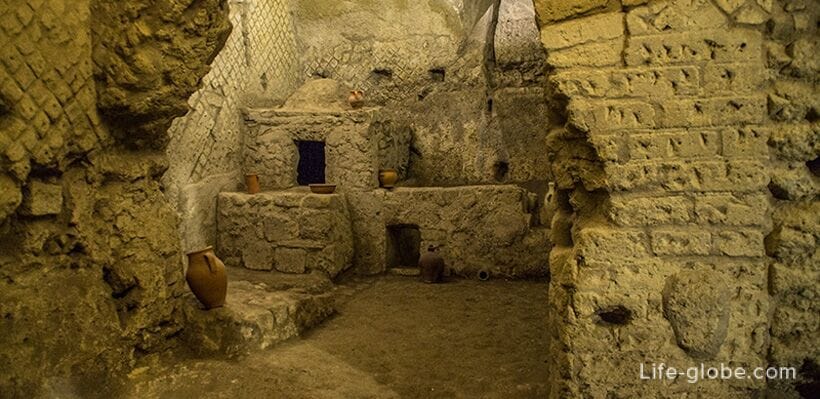

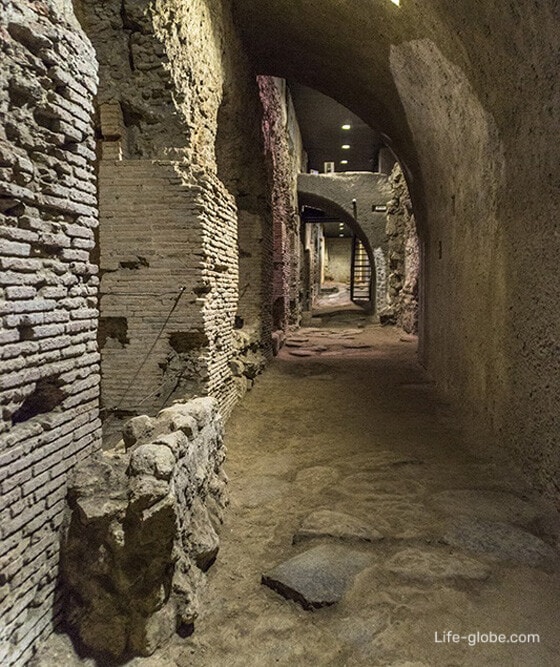
The tour starts from Piazza San Gaetano, 68 (to the left of the Church of San Paolo Maggiore) and includes a visit to the Greek tuff quarries, the ancient aqueduct, underground tanks and tunnels of the Roman era and the remnants of the Greco-Roman amphitheatre.
During the Second world war the cave was used as bomb shelter, therefore, under the bowels, you can see a tank and military Museum of Naples.
There are several companies offering tours under the name "Napoli Sotterranea" that can be misleading. Association Culturale Napoli Sotterranea was the first who introduced the beauty of the Neapolitan subsoil the world, after there are others, so the route is called "Napoli Sotterranea" is close to the Royal Palace.
If you want to visit a true historical complex "Napoli Sotterranea" should hold the path to Piazza San Gaetano, 68.
Duration two and a half hours. Tours are conducted in Italian and English. Tours in Italian: available every hour from 10:00 to 18:00 hours. Tours in English: every two hours from 10:00 to 18:00 hours. Tours in other languages, groups, or tours outside of normal operating hours is available by prior arrangement.
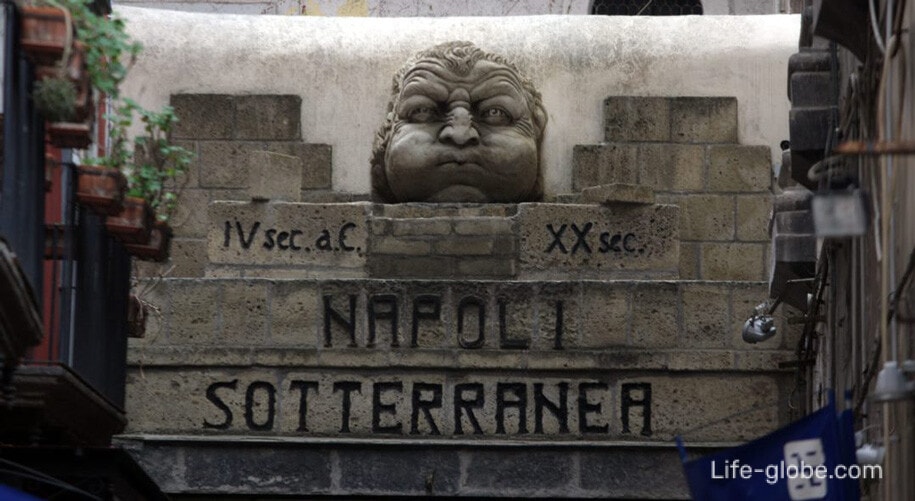
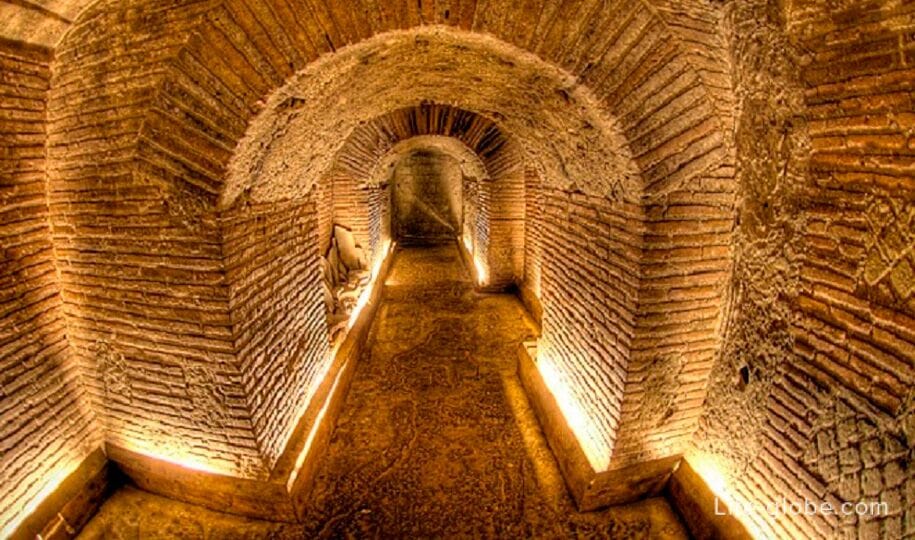
Gallery, at its core, includes: a system of underground tunnels that emerged in the 19th century, including the tunnel, belonging to branches of the aqueduct of Bolla seventeenth century.
19 Feb 1853, Ferdinando II de Bourbon signed a decree that ordered the design and construction of underground tunnels, passing under the mountain Ecia connecting the Royal Palace with Piazza Vittoria and barracks Nino Bixio.
Now gallery Bourbon is the pride of civil Bourbon underground construction. There is a Museum, which offers four types of tours (routes):
standard route (Percorso Standard), which includes the visit related to the aqueduct of Bolla, three bridges and walls built by the Bourbons in order of crossing of tanks, preserving their functionality; rooms adapted for military shelters during the Second world war, where were found many objects, fragments of statues, cars and motorcycles, the period between the end of world war II and 70 years;
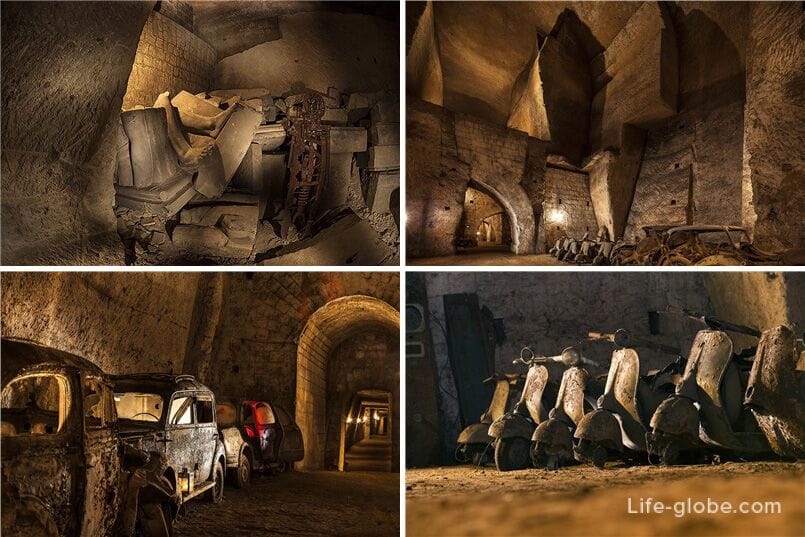
- path of memories (Via delle Memorie), including a visit to the octagonal courtyard and staircase of the Palazzo Serra di Cassano, and then the room where once housed joinery Palazzo; a small military Museum, created in the rooms with the artifacts found during the excavations, which lasted three years, and a visit to the quarries from which was extracted the tufa stone for the construction of the Palace, and then the aqueduct where the water tank;

- path adventures (Percorso Avventura), during which you can go through the tunnel and visit the cistern built in the late 1400 years, to see the engraved cross, to visit the "car room", then walk to the second large tank and see the arches of the 18th century, and then to achieve the part of the underground excavation, where the walls are engraved with the names and thoughts of the Neapolitans who had taken refuge in these areas during the Second world war;
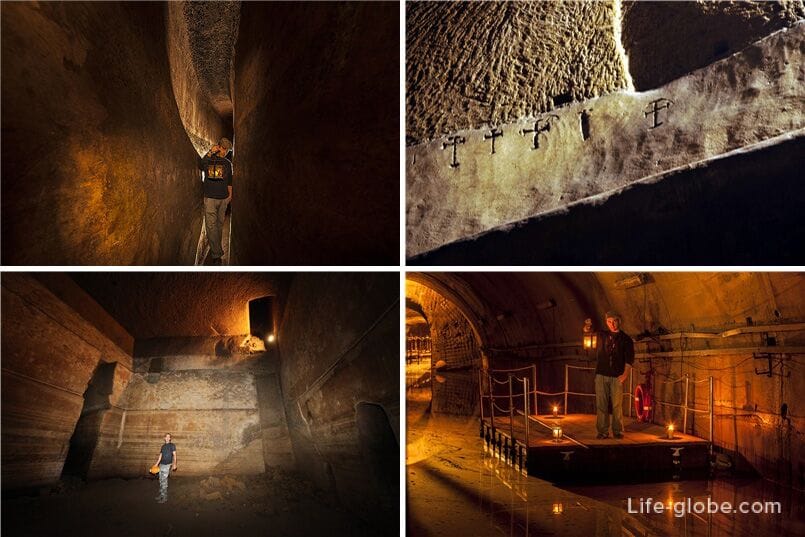
- light path (Percorso Speleo Light), during which, armed with a front slam will have the opportunity to explore the tunnels of the ancient underground aqueduct and reach the tanks, still partially filled with water and decorated with mysterious symbols. The itinerary includes a long walk through the narrow tunnels of the aqueduct "Bolla", to areas where you can see religious prints.
Sometimes the guides to change the itinerary and accompany tourists to places that re-open after the excavation, thus giving the opportunity to see guests something new and hitherto unknown.
The routes, cost and hours of tours can be found on the website.
Tour of the archaeological site includes visiting the remains of the amphitheatre and villas, as well as the Grotto di Seiano - artificial tunnel length of about 770 meters, crossing the tuff of the hill of Posillipo. The path of this ancient passage built about two thousand years ago by the architect Seiano.
The Park is located near the island of Nisida (Islet Of Nisida) - Western point of the coast of the city of Naples. To get from Naples city centre (near Piazza Plebiscito) by bus lines 140. You should get off at final stop - ring Piazza Capo di Posillipo, and then to come down to the island. Address Park Pausilypon: Discesa Coroglio, 36.
Time and conditions advise you to confirm before visiting. Site.
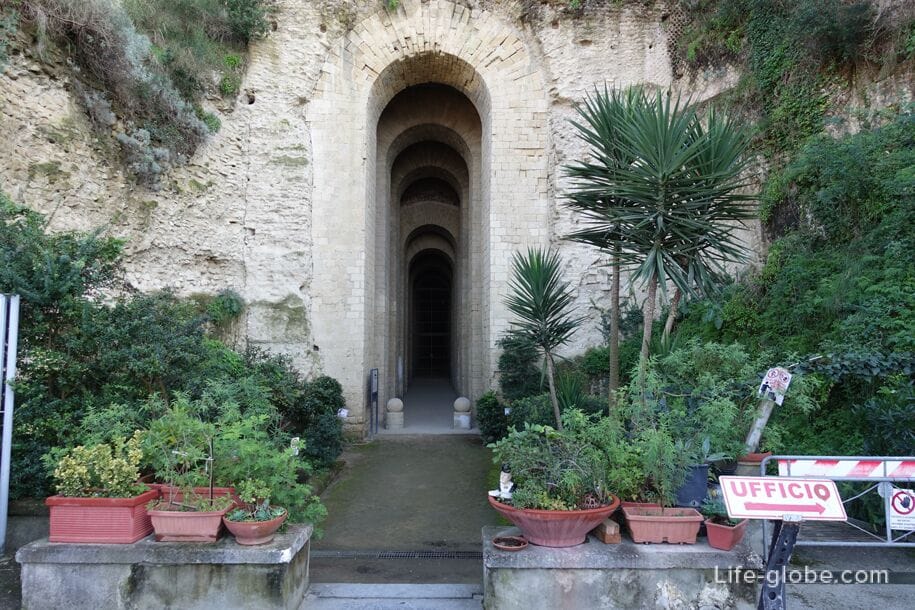
In Naples:
- archaeological site of Carminiello ai Mannesi a Napoli, located in the city centre and consisting of residues of the complex of baths of the Roman era Dating from the late 1st century BC.
Apsida part black-and-white mosaic floor were probably part of a private residence Republican era, which in the Imperial epoch were included in the foundations of large buildings with vaulted rooms.
During the excavations of the thermal baths, several reservoirs and marble relief representing the deity Mithras in the act of sacrifice of a bull.
The remains of the complex visible from the road;
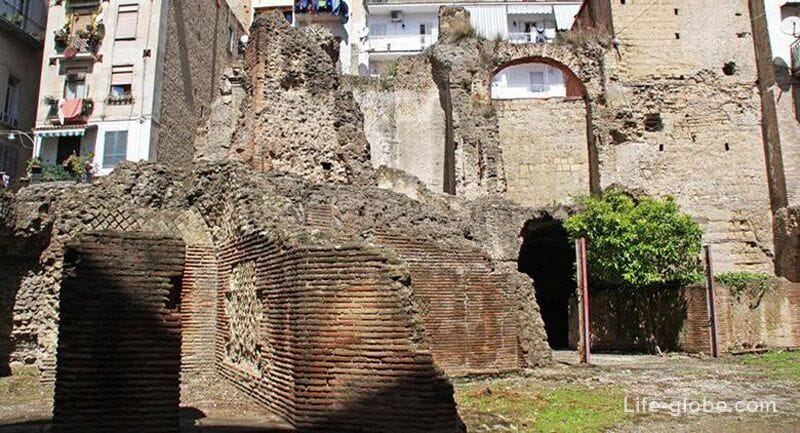
Museum at the monastery of Santa Chiara (Santa Chiara Scavi archeologici), which contains some remarkable things survived the explosion 1943 and archaeological sites - Roman baths, Dating from the first century ad.
The cost of a full ticket 6€, students and people over 65 years is 4.5 Euros. Hours of operation: Monday - Saturday from 9:30 to 17:30 hours Sunday from 10:00 to 14:30 hours. Last admission 30 minutes before closing.
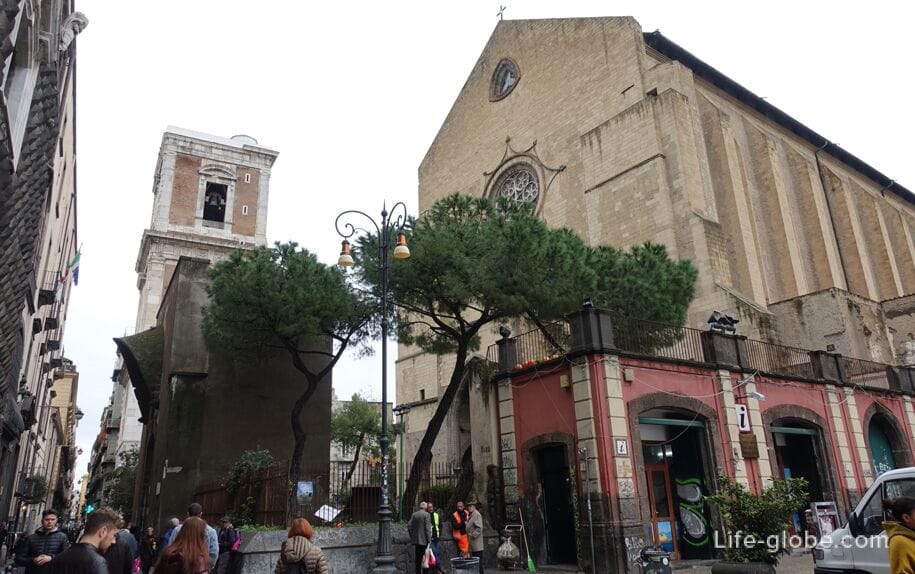
Near Naples:
- archaeological parks Herculaneum and the Pompeii archeological site - ancient Roman city, is famous because in 79 ad, was destroyed and buried under a layer of pyroclastic flows during the eruption of Vesuvius;
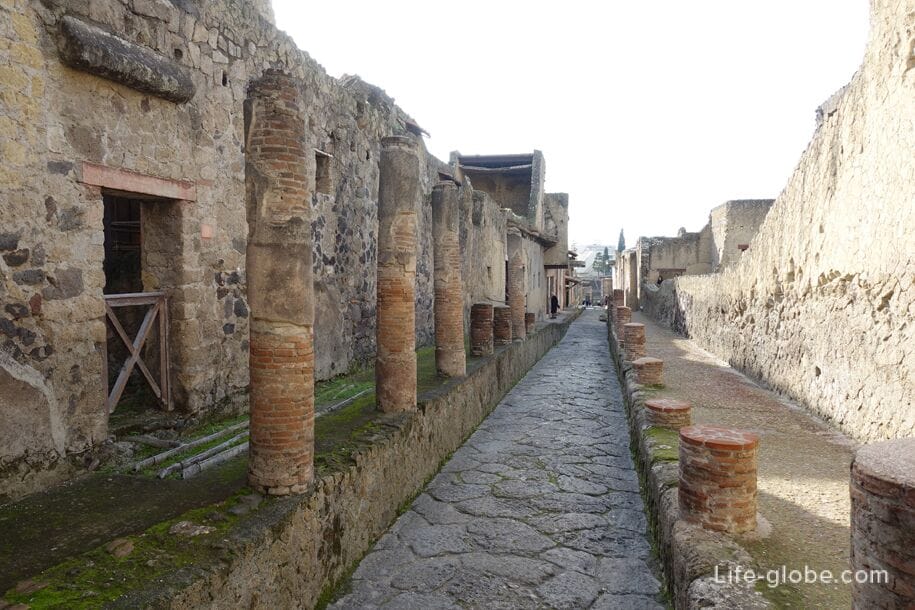
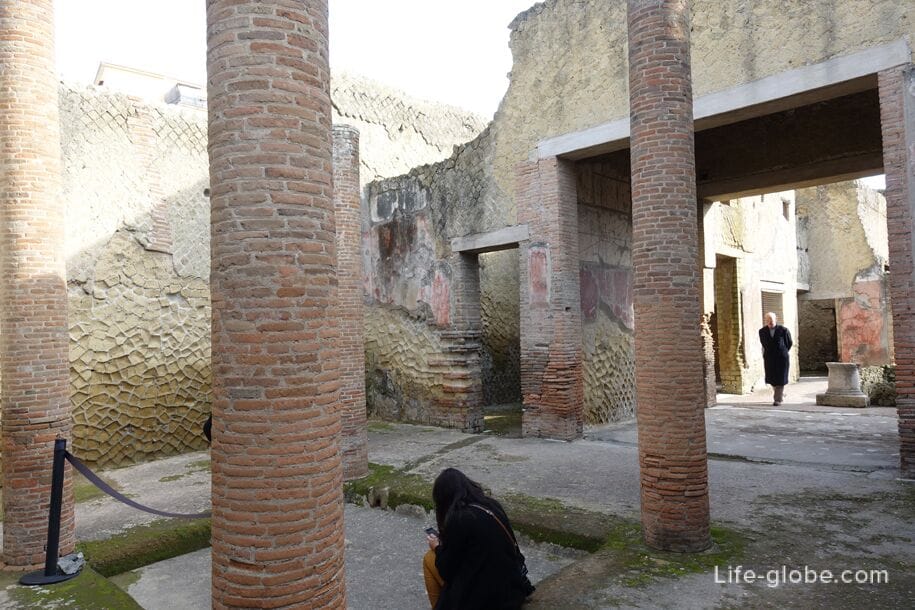
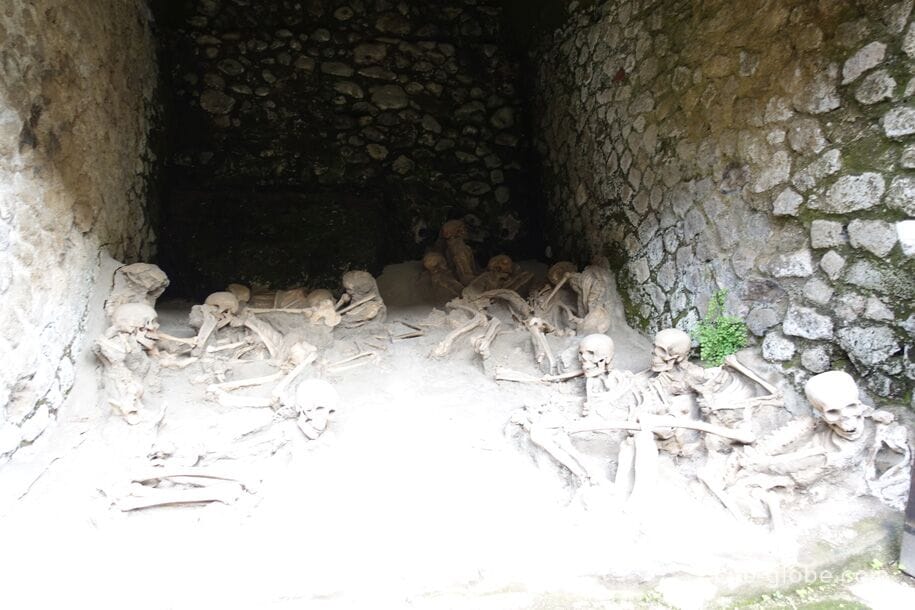
- Kuma (Sito Archeologico di Cuma), archaeological complex of the Terme di Baia (Complesso archeologico delle Terme di Baia) and the Flavian amphitheatre (Anfiteatro Flavio Neroniano).
The entrance to the archaeological Park and Phlegraean fields (Parco Archeologico dei Campi Flegrei): full ticket 4€, from 18 to 25 years - € 2, free for children under 18 years of age. Ticket valid for two days and includes visits to four sites: the archaeological Park of Baia + Amphitheatre + Cuma archaeological Park + Museum.
